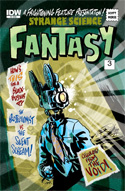by Tim Platt
I’ve been frustrated with Marvel comics for a while now, mainly with the continuity. The constant soap opera, the constant high stakes of a universe on the brink of collapse, the constant assumption that a bunch of freaks with powers have an obligation to help people. The philosophy that made Spider-Man such a revelation—“with great power comes great responsibility”—has infiltrated every character of the Marvel (and I would say comic book) universe. It’s transformed the sci-fi Fantastic Four, the monstrously self concerned X-men, the Frankenstein Hulk and the fucking crazy Thor/Doctor Strange into something they never were in their conception: superheroes.
Scott Morse’s recently-concluded 6 part mini-series Strange Science Fantasy stands in stark contrast. Or, rather, it stands on the shoulders of a comic book past often talked about but rarely incorporated into modern graphic storytelling. Published by IDW, each issue tells the origin story of some fantastical character who doesn’t even seem to be in the same universe as the character of the next issue. Characters include a shogun fitted for space travel (Shogunaut!), a projectionist with a projector as a head, a boxer turned rubber, and a WW II veteran turned into a giant to resist an alien invasion (G.I. Gantic, obviously). Like the early Kirby, Ditko, and Lee, Morse delivers narrative driven by bold artistry. Each page contains 3 rectangular panels with an overly pulpy narrator pushing the story along. No dialogue. Each story in art, design, and tone seem a direct echo to the early issues of the Marvel heroes, when the writers were inventive and iconic, before their turn towards melodrama and the interpersonal relationships of super-heroes (HOLY SHIT, Cyclops and Jean Gray are married but WOLVERINE IS A WILD CARD). The narrator—the only voice in the comic—is pretty entertaining. Unlike much comic narration, Scott Morse seems to be in character. It’s tongue and cheek wax poetry and every page giggles. Want some proof?
“THIS was one for all mankind. G.I. GANTIC. Oh, how lofty the view from a table turned? Let these cherubs of doom find their voices now! Sing! They fled to their temples. Tried to save their totems. Their souls. But nothing could hide from the eyes of G.I. Gantic. Especially not the truth.”
Like Stan Lee’s prose, the writing is over top and totally engaging. At its core, Strange Science Fantasy tells tales of humans struggling against the gods, against the establishment, and against themselves. It’s right out of the pulp origins of the modern comic book. And it’s fun.
This post may contain affiliate links.









